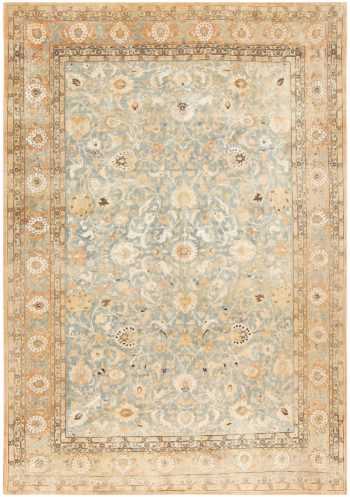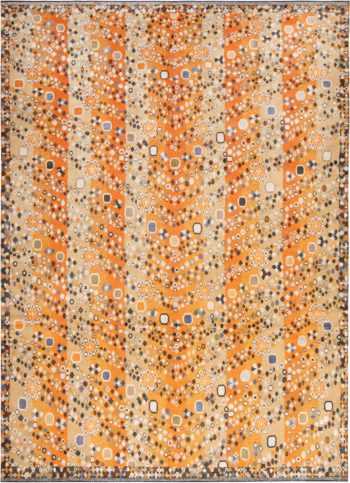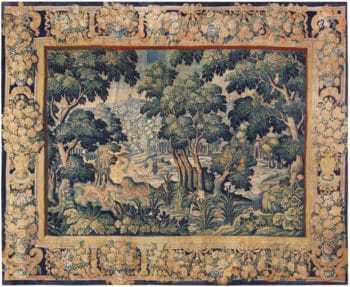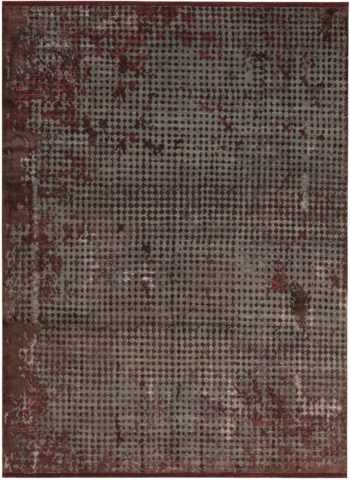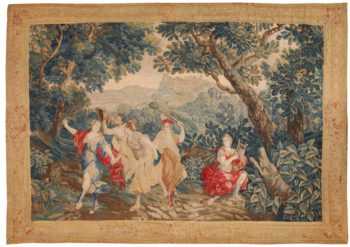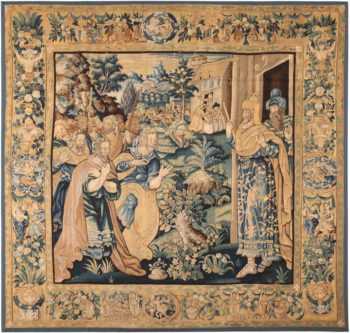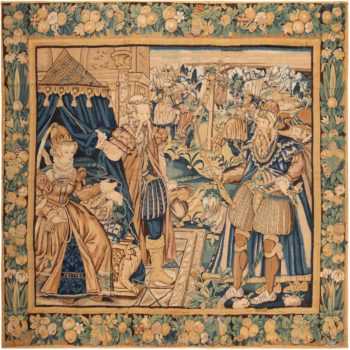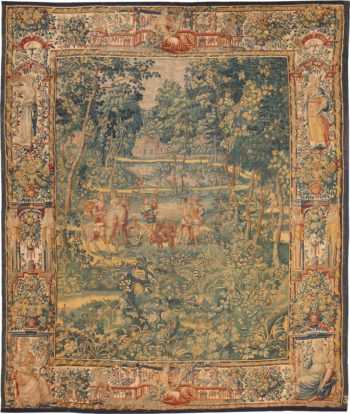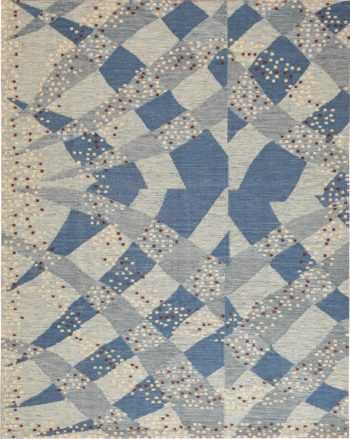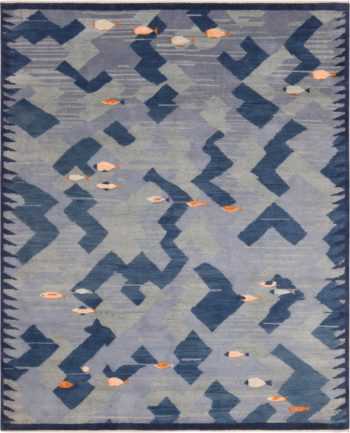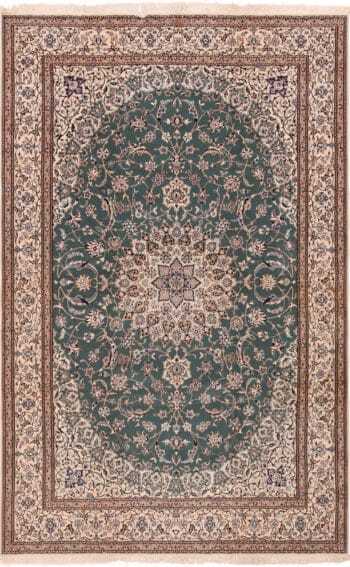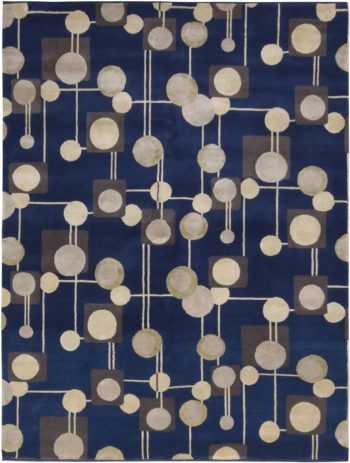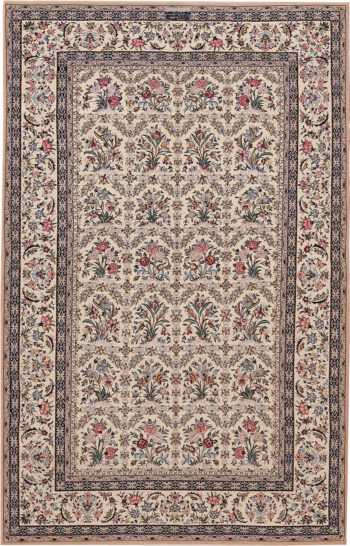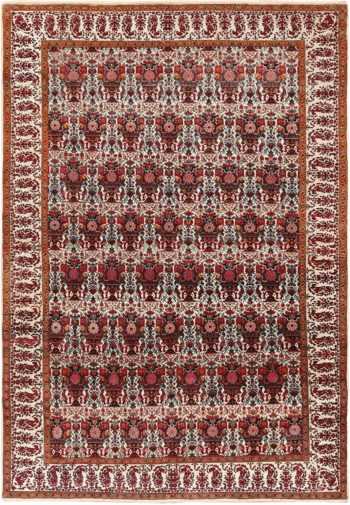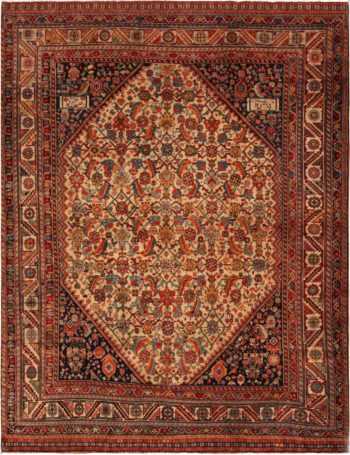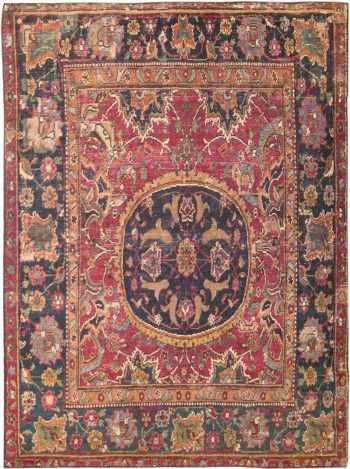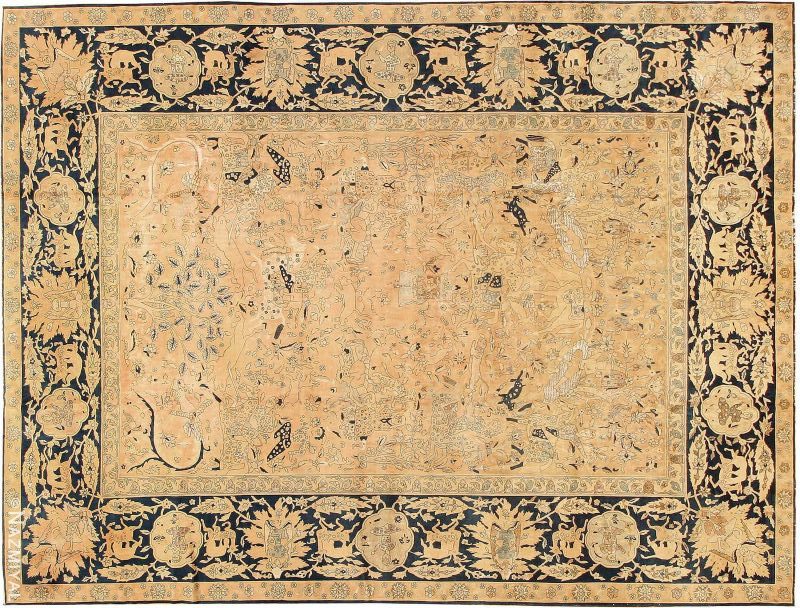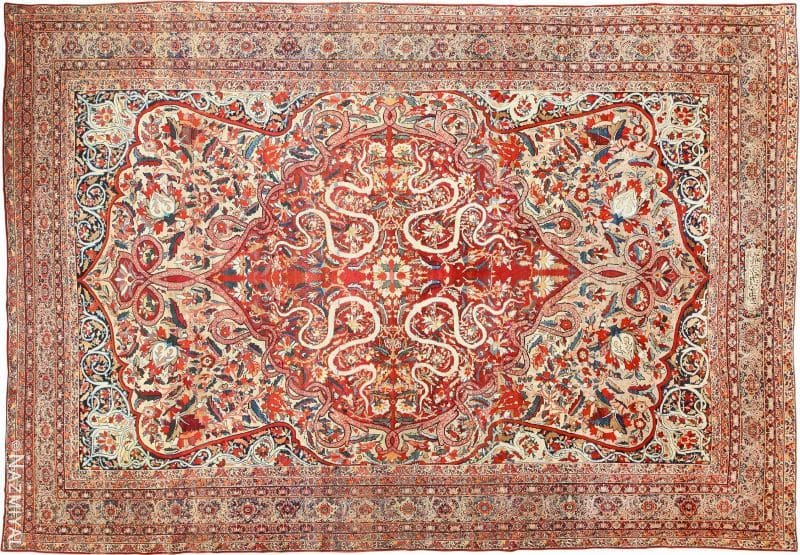Wool and Silk Rugs
View all the entire collection of antique wool and silk rugs and carpets below:
-
Large Silk And Wool Fine Vintage Persian Nain Area Rug 72483
$16,500.00Size: 10 ft 6 in x 16 ft 4 in (3.2 m x 4.98 m) -
Fine Luxurious Silk and Wool Antique Persian Tehran Rug 48249
$36,000.00Size: 10 ft 6 in x 15 ft 6 in (3.2 m x 4.72 m) -
Sunny Happy Swedish Inspired Mid Century Design Modern Area Rug 60902
$7,875.00Size: 10 ft 2 in x 14 ft 1 in (3.1 m x 4.29 m) -
17th Century Antique French Silk And Wool Verdure Tapestry 72574
$68,000.00Size: 10 ft x 12 ft 10 in (3.05 m x 3.91 m) -
17th Century Antique French Silk And Wool Animal Design Verdure Tapestry 72572
$68,000.00Size: 10 ft x 12 ft 5 in (3.05 m x 3.78 m) -
Stunning Modern Silk And Wool Swedish Inspired Rug 60962
$6,055.00Size: 9 ft x 12 ft (2.74 m x 3.66 m) -
Artistic Abstract Wool and Silk Modern Transitional Area Rug 60978
$10,220.00Size: 9 ft x 12 ft (2.74 m x 3.66 m) -
17th Century Wool and Silk Romantic Antique French Verdure Tapestry 70857
$79,000.00Size: 8 ft x 11 ft 4 in (2.44 m x 3.45 m) -
16th Century Silk And Wool Antique Flemish Old Testament Biblical Tapestry 72008
$78,000.00Size: 10 ft 8 in x 11 ft 3 in (3.25 m x 3.43 m) -
16th Century Antique Silk And Wool Biblical Flemish Jewish Purim Tapestry 72009
$56,000.00Size: 10 ft 2 in x 10 ft 9 in (3.1 m x 3.28 m) -
Refined 17th Century Wool and Silk Antique French Hunting Scene Verdure Tapestry 70856
$110,000.00Size: 8 ft 7 in x 10 ft 3 in (2.62 m x 3.12 m) -
Silk And Wool Modern Swedish Inspired Kilim Rug 60927
$3,500.00Size: 8 ft 3 in x 10 ft 2 in (2.51 m x 3.1 m) -
Fish Design Modern Swedish Inspired Rug 60991
$3,850.00Size: 8 ft 2 in x 9 ft 11 in (2.49 m x 3.02 m) -
Vibrant Silk And Wool Modern Swedish Inspired Round Blue Rug 60925
$5,425.00Size: 9 ft 10 in x 9 ft 10 in (3 m x 3 m) -
17th Century Wool and Silk Antique French Tapestry 70858
$79,000.00Size: 8 ft 1 in x 9 ft 7 in (2.46 m x 2.92 m) -
Fine Wool And Silk Vintage Persian Nain Rug 72462
$6,900.00Size: 5 ft 11 in x 8 ft 11 in (1.8 m x 2.72 m) -
Blue Circle Mid Century Modern Rug 60750
$4,060.00Size: 6 ft 3 in x 8 ft 2 in (1.9 m x 2.49 m) -
Small Vintage Persian Silk and Wool Isfahan Rug 70784
$6,750.00Size: 4 ft 2 in x 6 ft 8 in (1.27 m x 2.03 m) -
Blue Square Silk and Wool Garo Antreasian Art Rug 49950
$8,500.00Size: 5 ft 7 in x 6 ft (1.7 m x 1.83 m) -
Fine Antique Ivory Silk and Wool Persian Vase and Paisley Deign Farahan Rug 44916
$6,900.00Size: 4 ft 1 in x 5 ft 10 in (1.24 m x 1.78 m) -
Antique Persian Silk Foundations Qashqai Signed Rug 71805
Size: 4 ft 4 in x 5 ft 6 in (1.32 m x 1.68 m) -
Colorful Antique Floral Chinese Embroidery 70651
$4,600.00Size: 2 ft x 5 ft (0.61 m x 1.52 m) -
Antique 17th Century Persian Isfahan Rug 8034
Size: 2 ft 10 in x 3 ft 6 in (0.86 m x 1.07 m) -
Antique Wool And Silk Scottish Needlepoint Textile Art Sampler 46055
$2,200.00Size: 2 ft x 3 ft (0.61 m x 0.91 m)
Learn More About Wool and Silk Rugs
What is a silk and wool rug?
A silk and wool rug is a type of rug made from a blend of silk and wool fibers. Both silk and wool are natural fibers with unique qualities, and combining them in a rug creates a product that aims to leverage the benefits of each material.
Here are some characteristics of silk and wool in the context of rugs:
- Wool:
- Durable: Wool is known for its durability and resilience, making it a popular choice for rugs.
- Naturally Resistant: Wool fibers are naturally resistant to stains and wear, making them suitable for high-traffic areas.
- Silk:
- Luxurious: Silk has a luxurious and soft feel, adding a touch of elegance to the rug.
- Smooth Texture: Silk fibers are smooth and shiny, contributing to the visual appeal of the rug.
When combined, silk and wool rugs often aim to achieve a balance between durability and luxury. The wool provides strength and resistance to wear, while the silk adds a lustrous sheen and a softer texture. The ratio of silk to wool can vary, and it influences the overall look and feel of the rug.
These rugs are often handcrafted, and the weaving or knotting techniques used can further enhance their quality and appearance. Additionally, the design and patterns on silk and wool rugs can showcase the craftsmanship and artistry of the weavers.
It’s important to note that silk and wool blend rugs may require specific care and cleaning methods to preserve their beauty and integrity. Checking with the manufacturer or retailer for care instructions is advisable when considering such rugs for your home.
Are wool and silk blend rugs durable?
Wool and silk blend rugs can be durable, but their longevity depends on various factors such as the quality of materials, construction, and how well they are maintained. Both wool and silk are natural fibers with unique characteristics.
Wool is known for its resilience, elasticity, and ability to resist stains. It is a popular choice for rugs due to its durability and natural resistance to wear. Silk, on the other hand, is more delicate and luxurious but can be less resilient to heavy foot traffic.
When blended together, the combination of wool and silk can create a rug that combines the durability of wool with the luxurious feel of silk. However, it’s essential to consider the ratio of wool to silk, as a higher percentage of wool may enhance durability.
Regular maintenance, proper cleaning, and following care instructions are crucial for prolonging the life of any rug, including wool and silk blends. It’s advisable to consult with the rug manufacturer or retailer for specific care guidelines based on the composition of the rug you are considering.
How can you tell if a rug is silk and wool?
Determining whether a rug is made of silk and wool can involve a combination of visual inspection, touch, and sometimes consulting the rug’s label or documentation.
Here are some methods to help identify if a rug is made of silk and wool:
- Visual Inspection:
- Fiber Characteristics: Examine the fibers closely. Wool fibers are thicker and have a matte appearance, while silk fibers are finer and have a shiny, smooth surface.
- Sheen: Silk has a natural luster and reflective quality that gives it a shiny appearance. Look for areas where the rug catches the light to identify any silk content.
- Touch and Feel:
- Texture: Run your fingers through the rug’s fibers. Wool feels coarse and has a more textured surface, while silk feels smooth and soft to the touch.
- Temperature Sensitivity: Silk tends to be cooler to the touch compared to wool.
- Check the Label:
- Manufacturer’s Information: Look for a label or documentation that provides information about the rug’s materials. Manufacturers often include details about the fiber content.
- Burn Test (Caution):
- Burn Test for Wool: Wool is a protein fiber, so it will smell like burning hair when a small piece is burned. It also forms a grayish ash.
- Burn Test for Silk: Silk is a protein fiber like wool, so it will also smell like burning hair. However, silk forms a black, crispy ash.
- Consult an Expert:
- If in doubt, consider consulting a rug expert or professional appraiser. They can use their expertise to identify the materials used in the rug.
Some rugs may be labeled as a silk and wool blend, and the ratio of silk to wool can vary. Additionally, handmade rugs may exhibit unique characteristics based on the craftsmanship and region of origin. When purchasing a rug, it’s advisable to ask the seller for information about the materials used and care instructions.
Are wool and silk rugs hard to clean?
Wool and silk rugs require careful cleaning to maintain their appearance and integrity.
Here are some considerations for cleaning wool and silk rugs:
- Regular Vacuuming: Both wool and silk rugs benefit from regular vacuuming to remove dust and debris. Use a vacuum cleaner with adjustable height settings to avoid damaging the fibers.
- Spot Cleaning: Deal with spills promptly by blotting rather than rubbing the affected area. Use a clean, white cloth or paper towel to absorb the spill. Avoid using harsh chemicals that may damage the fibers.
- Professional Cleaning: It’s recommended to have wool and silk rugs professionally cleaned to ensure thorough and safe cleaning. Professional cleaners have the expertise to handle delicate fibers without causing damage.
- Avoid Water: Excessive moisture can be detrimental to silk fibers, so it’s essential to avoid over-wetting silk rugs during cleaning. Wool is more tolerant of moisture but should also be dried thoroughly to prevent mold or mildew.
- Test Cleaning Products: Before using any cleaning product on a wool or silk rug, it’s wise to test it in an inconspicuous area to ensure it doesn’t cause discoloration or damage.
- Rotate the Rug: Periodically rotate the rug to ensure even wear and exposure to light.
- Use Rug Pads: Placing rug pads underneath wool and silk rugs helps prevent slipping and provides an extra layer of protection.
Given the delicacy of silk fibers, it’s crucial to exercise caution during cleaning to avoid damage. Always refer to the manufacturer’s care instructions or consult with a professional cleaner for specific guidance based on the type and construction of the rug.
What is so special about wool and silk rugs?
Wool and silk rugs are considered special and highly valued for several reasons, including their unique qualities, luxurious appearance, and the craftsmanship involved in their creation.
Here are some aspects that make wool and silk rugs special:
- Natural Fibers:
- Both wool and silk are natural fibers, making them desirable for those seeking environmentally friendly and sustainable materials.
- Durability:
- Wool is known for its durability and resilience. Wool fibers can withstand high traffic areas and resist wear, making wool rugs long-lasting.
- The combination of wool and silk in a rug may enhance durability by combining the strength of wool with the luxurious feel of silk.
- Luxurious Aesthetics:
- Silk adds a touch of luxury and elegance to rugs. Silk fibers have a smooth texture and natural sheen that can create a lustrous and visually appealing surface.
- The combination of wool’s durability with silk’s luxurious appearance makes these rugs unique and aesthetically pleasing.
- Softness:
- Silk is known for its soft and silky feel. When blended with wool, it can add a softer texture to the rug, creating a comfortable and inviting surface.
- Craftsmanship:
- Many wool and silk rugs are handmade using traditional weaving or knotting techniques. The craftsmanship involved in creating these rugs contributes to their uniqueness and value.
- Handmade rugs often feature intricate designs, patterns, and colors, showcasing the skill and artistry of the weavers.
- Cultural Significance:
- Wool and silk rugs are often associated with cultural traditions and heritage. Different regions have distinct weaving styles and patterns that contribute to the cultural richness of these rugs.
- Temperature Regulation:
- Wool has natural insulating properties, providing warmth in colder seasons and coolness in warmer weather. This makes wool rugs comfortable in a variety of climates.
- Stain Resistance:
- Wool fibers are naturally resistant to stains and spills, making wool rugs easier to maintain and clean.
While these qualities make wool and silk rugs special, it’s essential to note that they may require specific care and maintenance. Following recommended cleaning instructions and caring for these rugs properly can help preserve their beauty and longevity.
More about area rugs that were made using both silk and wool:
Wool is an extremely durable fiber. This is one of the reasons it gets used so frequently in the area rug weaving industry. Since rugs get walked on, they need to be durable to withstand daily traffic and use. Wool is also naturally biodegradable and sustainable. No sheep are harmed during the cultivation of the wool for weaving wool rugs. The sheep get sheared in spring to rid them of an overly warm winter coat. Then it regrows in time to protect them again the following winter. You can think of it as getting a short summertime hair cut.
Silk is another natural fiber. Although most people think silk (or silk rugs) as being more delicate, in it’s natural untreated form, Silk it actually just as durable (if not more so) as wool. So don’t let its reputation as a fragile fabric fool you. Silk is still a durable material and quite suitable for weaving rugs, especially upscale art pieces.
When wool and silk are combined to make a rug, the wool is usually used to make the base or background of the rug and the silk is used to create or highlight the design. Silk is naturally softer and shinier. Silk fibers also have a tremendous affinity for dye. It can also be spun much finer that wool, allowing for a much finer weave which (as in more knots per square inch or KPSI), in turn, can translate into much more detailed and refined patterns.
Wool and silk rugs provide tremendous warmth under foot while greatly enhancing the décor. Or you can hang them on the wall as an art carpets or tapestry rugs.
A wool plus silk rug typically have an add dimension of depth than a rug that is 100 percent wool. It is also usually more attention grabbing. This is due mostly to the fact that the silk highlights or patterns will pop against and stand out more prominently than the wool.
The combination of both silk with wool is very much a winning combination. silk and wool rugs retains much of the hard wearing functionality of just wool carpets while increasing the aesthetic appeal of the final area rug. Silk and wool rugs require no more rug maintenance or rug cleaning than carpets that are only made out of wool.
A wool and silk rug can easily be the foundation for the interior décor of a room. If you start with the Oriental rug and then choose furnishings and paint or wallpaper to suit the rug, you can achieve an enviable room!
Major Differences Between Wool and Silk Rugs
View Our Entire Collection of : Antique Silk Rugs | Vintage Persian Silk Rugs
Wool and silk are the two most common materials used in high-end rugs. Each material offers unique benefits and drawbacks for both rug weavers and buyers. Whether you want a luxury rug for your home or an artistic rug as an investment, understanding the material is important. What is the difference between silk rugs vs. wool rugs?
Silk Rugs Vs. Wool Rugs When Weaving
Silk is significantly finer than wool. When weaving, this allows the artisan to create more complex and precise patterns. Of course, silk rugs are also significantly more challenging to make. Hand weaving is already an intricate skill, and using a material that is exceptionally fine requires even an greater level of skill. Furthermore, silk is more expensive to source than even the highest-quality wools, so it is less likely to be used in a lower quality rug. Historically, only skilled artisans working in cities worked with silk, but silk is more readily available today. Nonetheless, modern rugs made with silk still require masterful skill to make.
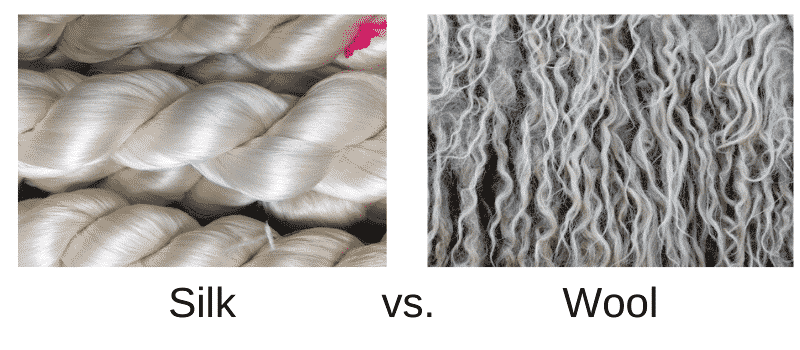
Silk fibers are noticeably finer than wool fibers.
Silk Rugs Vs. Wool Rugs When Buying
Due to the greater challenge and higher material cost, you can expect silk rugs to typically be more costly than wool ones, but labor and material costs are not the only factors in valuing a rug. A high-end rug made from wool can be more expensive and desirable than a silk rug in some cases. There are several factors to consider when choosing a rug material as a buyer.
- Durability: Wool rugs are very durable. The piles are thick and strong and naturally resistant to spills and stains. You can expect a wool rug to last for decades of regular use. Silk rugs are also durable but less so than wool. They will not stand up to the same level of foot traffic and and are more sensitive to liquid spills. For this reason, silk may be blended or used as an accent with wool on some rugs to highlight both fibers’ attributes.
- Appearance: Wool is an attractive material and can hold dyes very well, and many wool rugs are very beautiful. Nonetheless, it is quite similar to other rug materials in appearance. Silk, conversely, is highly sought after for its unique beauty. The material shimmers and is very pleasing. Silk rugs also typically offer more intricate and unique designs.
- Care: Since wool rugs are durable, they can be cleaned relatively easily, and they should and can be vacuumed often. If there is a stain, you can spot clean it with a detergent. Silk rugs, however, need more delicate care and should not be cleaned with hot water or steam. For high-end wool and silk rugs, you should consider using a professional cleaning service for the best results.
- Cost: As mentioned, silk is more expensive to source than wool. Unsurprisingly, this transfers into the cost of the rug for the buyer. Additionally, since silk rugs are often made to be very intricate, they may be more expensive. Of course, for high-end rugs, the artistry, provenance and techniques are often more important than the material in determining cost.
- Touch: Different wools can feel very different. High-end wools are very luxurious to the touch, and larger piles of wool will typically make the rug feel more substantial and thick. Silk rugs are much more delicate to the touch due to the finer piles. However, because silk is sometimes mixed with wool, some silk rugs feel quite similar to wool rugs.
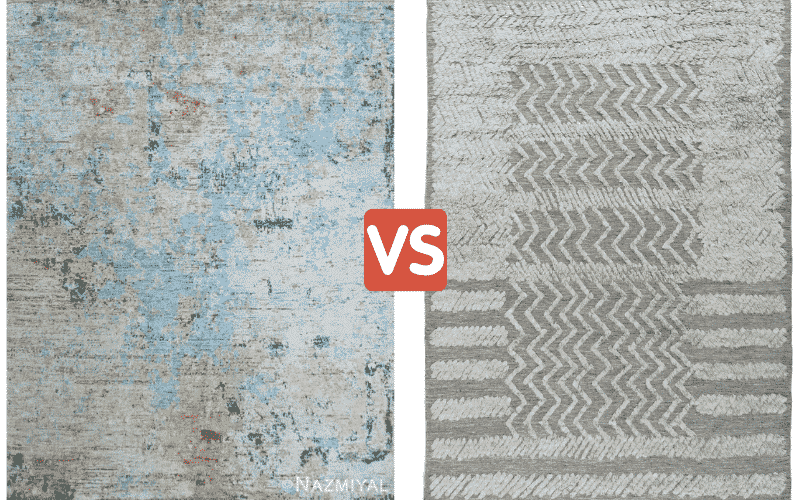
A rug woven with silk (left) vs. a rug woven with wool (right).
Silk Rugs Vs. Wool Rugs – Which to Choose?
Wool and silk rugs can both be very luxurious and worth owning. Typically, silk rugs are more expensive and sought after. The exclusivity of silk and the skill necessary to weave it have made it the material of choice of many masterful artisans. If you are looking for a rug as an art piece or for display, silk is likely the right choice of material. If you want a rug that you can use in a commonly visited part of your home, wool may be the better choice, and it is also often more budget-friendly. That does not mean that a wool rug is necessarily cheap, however. The size, origin, complexity, and knots per square inch / KPSI also have a huge impact on the price. Ultimately, you should choose a rug that you like or think will work well as an investment. Material plays a role in both of these criteria but should not be the only factor in consideration.
Other Materials
In addition to wool and silk, rugs can be made from linen, viscose, bamboo, or banana silk. These materials are typically used for alternatives or to create other textures accented with the wool and silk staple fibers.
Find High-End Wool and Silk Rugs
Whether you want a high-end wool or silk rug, Nazmiyal can help you. Explore our collection of antique, modern and vintage rugs. We are confident we can help you find the right piece for your needs. Consult our experts if you need help or contact us to learn more.


